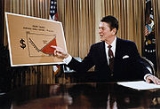
Reaganomics
Overview
Economics
Economics is the social science that analyzes the production, distribution, and consumption of goods and services. The term economics comes from the Ancient Greek from + , hence "rules of the house"...
policies promoted by the U.S. President Ronald Reagan
Ronald Reagan
Ronald Wilson Reagan was the 40th President of the United States , the 33rd Governor of California and, prior to that, a radio, film and television actor....
during the 1980s, also known as supply-side economics
Supply-side economics
Supply-side economics is a school of macroeconomic thought that argues that economic growth can be most effectively created by lowering barriers for people to produce goods and services, such as lowering income tax and capital gains tax rates, and by allowing greater flexibility by reducing...
and called trickle-down economics
Trickle-down economics
"Trickle-down economics" and "the trickle-down theory" are terms used in United States politics to refer to the idea that tax breaks or other economic benefits provided by government to businesses and the wealthy will benefit poorer members of society by improving the economy as a whole...
, particularly by critics. The four pillars of Reagan's economic policy were to:
- Reduce government spending increase
- Reduce income tax and capital gains tax
- Reduce government regulation
- Control money supply to reduce inflation
William A. Niskanen
William A. Niskanen
William Arthur Niskanen was an American economist noted as one of the architects of President Ronald Reagan's economic programme and for his contributions to public choice theory. He was also a long-time chairman of the libertarian Cato Institute.-Education:Niskanen received his B.A. from Harvard...
, one of the architects of Reaganomics, summarizes the policy as "Reagan delivered on each of his four major policy objectives, although not to the extent that he and his supporters had hoped," and notes that the most substantial change was in the tax code, where the top marginal individual income tax rate fell from 70.1% to 28.4%, and there was a "major reversal in the tax treatment of business income," with effect of "reducing the tax bias among types of investment but increasing the average effective tax rate on new investment." Roger Porter, another architect of the program, acknowledges that the program was weakened by the many hands that changed the President's calculus, such as Congress.
Unanswered Questions

